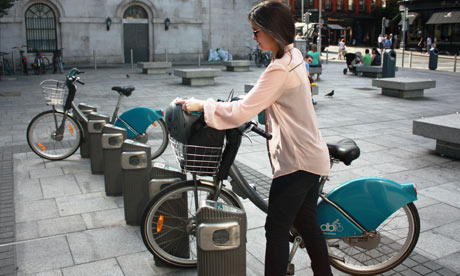Dublinbikes, the Irish capital's bike hire scheme, will turn two years old this September. With over 58,000 subscribers and 2.2m rentals to date, it has been reported as one of the most successful bike rental schemes in the world. In Dublin, each bike made an average of more than 2,200 journeys in its first year. Comparatively, London's scheme which was a year old at the start of July recorded an average of 1,000 journeys per bike over the year. So what is dublinbikes' secret to success?
The scheme is a joint partnership between Dublin city council and French company JC Decaux. Jason Frehill of Dublin city council project manages the scheme and says its success was due to three main factors: "The fact that the public in Dublin embraced the scheme and are now its guardians, the time taken to find the best location of each station, and the quality of the service delivered by JC Decaux." He explained that the high uptake of dublinbikes was further facilitated by the low annual fee which is a €10 nominal charge.
Dublin city council aims to have a free public transport system for citizens of Dublin and currently 97% of the scheme's usage is under the 30-minute threshold, making it free for users. Any journeys longer than this are charged for.
Everyone I talked to about dublinbikes responded positively, whether they were infrequent or regular users. A dublinbikes subscriber mentioned that maintenance costs and fear of robbery of a private bike was her motivation for using the public scheme. The bike scheme has even had a positive effect on private bike users. One cyclist said: "As a daily bike commuter, dublinbikes are great. Since they have been here cars are much more aware of cyclists."
The scheme is also being adopted as a mode of transport by visitors to the city, who get a three day subscription for €2. One Dubliner owns his own bike but joined the public scheme so that he can have a spare bike for his guests.
The success of the bike scheme has prompted plans for an expansion from its current 550 bikes and 44 stations to 5,000 bikes and 300 stations. Bike stations are currently located in close proximity to areas of high employment, amenities and other transport services. The planned expansion will bring bike stations to the suburbs.
One of the main issues when cycling in Dublin is that in many areas the cycle lane is also part of the bus lane. When asked about this, Frehill said that development of cycle lanes will be part of the dublinbikes expansion. The council is in the process of developing a strategic approach for an integrated cycle network.
Personally I love dublinbikes and find it the quickest way to travel around the city centre. Conveniently bike stations are outside my favourite restaurant and near my bus stop. I was not surprised to hear that the council attributes much of its success to the people of Dublin. We are all very proud of this scheme and it has been a positive story in all our recent doom and gloom.
• Maria Daly blogs at Science Calling!
